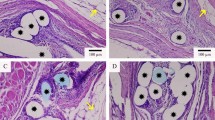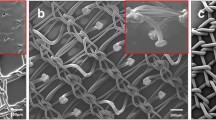Abstract
Purpose
Mesh-related infection is a critical outcome for patients with hernia defect stabilized with synthetic or biological meshes. Even though bioactive meshes loaded with antibiotics or antiseptics are slowly emerging in the market, the available solutions still lack versatility. Here, we proposed a polymer solution, i.e., hyaluronic acid-poly(N-isopropylacrylamide) (HApN), which forms a hydrogel to be used as coating for meshes only when it reaches body temperature.
Methods
We assessed how the gelation of HApN was influenced by the incorporation of different antibiotic and antiseptic formulations, and how this gel can be used to coat several mesh types. The impact of the coating on the elastic behavior of a macroporous mesh was tested under cyclic elongation condition. Finally, we selected two different coating formulations, one based on antibiotics (gentamicin + rifampicin) and one based on antiseptic (chlorhexidine) and tested in vitro their antimicrobial efficacies.
Results
HApN can be used as carrier for different antimicrobial agents, without having a strong influence on its gelation behavior. Porous or dense meshes can be coated with this polymer, even though the stability was not optimal on macroporous meshes such as Optilene when pores are too large. HApN loaded with drugs inhibited in vitro the growth of several Gram-positive and Gram-negative bacteria.
Conclusion
Compared to the available technologies developed to endow meshes with antibacterial activity, the proposed HApN offers further versatility with potential to prevent mesh-related infection in hernioplasty.






Similar content being viewed by others
References
Brown RH, Subramanian A, Hwang CS, Chang S, Awad SS (2013) Comparison of infectious complications with synthetic mesh in ventral hernia repair. Am J Surg 205(2):182–187. https://doi.org/10.1016/j.amjsurg.2012.02.023
Falagas ME, Kasiakou SK (2005) Mesh-related infections after hernia repair surgery. Clin Microbiol Infect 11(1):3–8. https://doi.org/10.1111/j.1469-0691.2004.01014.x
Dabbas N, Adams K, Pearson K, Royle G (2011) Frequency of abdominal wall hernias: is classical teaching out of date? JRSM Short Rep 2(1):5–5. https://doi.org/10.1258/shorts.2010.010071
Kingsnorth A, LeBlanc K (2003) Hernias: inguinal and incisional. Lancet 362(9395):1561–1571. https://doi.org/10.1016/S0140-6736(03)14746-0
Oliveira WF, Silva PMS, Silva RCS, Silva GMM, Machado G, Coelho L et al (2018) Staphylococcus aureus and Staphylococcus epidermidis infections on implants. J Hosp Infect 98(2):111–117. https://doi.org/10.1016/j.jhin.2017.11.008
Enzler MJ, Berbari E, Osmon DR (2011) Antimicrobial prophylaxis in adults. Mayo Clin Proc 86(7):686–701. https://doi.org/10.4065/mcp.2011.0012
Guillaume O, Perez-Tanoira R, Fortelny R, Redl H, Moriarty TF, Richards RG et al (2018) Infections associated with mesh repairs of abdominal wall hernias: are antimicrobial biomaterials the longed-for solution? Biomaterials 167:15–31. https://doi.org/10.1016/j.biomaterials.2018.03.017
Cobb WS, Paton BL, Novitsky YW, Rosen MJ, Kercher KW, Kuwada TS et al (2006) Intra-abdominal placement of antimicrobial-impregnated mesh is associated with noninfectious fever. Am Surg 72(12):1205–1208 (Discussion 1208-9)
Baker EH, Lepere D, Lundgren MP, Greaney PJ, Ehrlich DA, Copit SE et al (2016) Early clinical outcomes of a novel antibiotic-coated, non-crosslinked porcine acellular dermal graft after complex abdominal wall reconstruction. J Am Coll Surg 223(4):581–586. https://doi.org/10.1016/j.jamcollsurg.2016.05.022
Perez-Kohler B, Bayon Y, Bellon JM (2016) Mesh infection and hernia repair: a review. Surg Infect (Larchmt) 17(2):124–137. https://doi.org/10.1089/sur.2015.078
Guillaume O, Teuschl AH, Gruber-Blum S, Fortelny RH, Redl H, Petter-Puchner A (2015) Emerging trends in abdominal wall reinforcement: bringing bio-functionality to meshes. Adv Healthc Mater 4(12):1763–1789. https://doi.org/10.1002/adhm.201500201
D'Este M, Alini M, Eglin D (2012) Single step synthesis and characterization of thermoresponsive hyaluronan hydrogels. Carbohydr Polym 90(3):1378–1385. https://doi.org/10.1016/j.carbpol.2012.07.007
Ter Boo GA, Arens D, Metsemakers WJ, Zeiter S, Richards RG, Grijpma DW et al (2016) Injectable gentamicin-loaded thermo-responsive hyaluronic acid derivative prevents infection in a rabbit model. Acta Biomater 43:185–194. https://doi.org/10.1016/j.actbio.2016.07.029
Perez-Kohler B, Benito-Martinez S, Rodriguez M, Garcia-Moreno F, Pascual G, Bellon JM (2019) Experimental study on the use of a chlorhexidine-loaded carboxymethylcellulose gel as antibacterial coating for hernia repair meshes. Hernia. https://doi.org/10.1007/s10029-019-01917-9
Wiegering A, Sinha B, Spor L, Klinge U, Steger U, Germer CT et al (2014) Gentamicin for prevention of intraoperative mesh contamination: demonstration of high bactericide effect (in vitro) and low systemic bioavailability (in vivo). Hernia 18(5):691–700. https://doi.org/10.1007/s10029-014-1293-x
Guillaume O, Garric X, Lavigne JP, Van Den Berghe H, Coudane J (2012) Multilayer, degradable coating as a carrier for the sustained release of antibiotics: preparation and antimicrobial efficacy in vitro. J Control Release 162(3):492–501. https://doi.org/10.1016/j.jconrel.2012.08.003
Majumder A, Scott JR, Novitsky YW (2016) Evaluation of the antimicrobial efficacy of a novel rifampin/minocycline-coated, noncrosslinked porcine acellular dermal matrix compared with uncoated scaffolds for soft tissue repair. Surg Innov 23(5):442–455. https://doi.org/10.1177/1553350616656280
Sadava EE, Krpata DM, Gao Y, Novitsky YW, Rosen MJ (2013) Does presoaking synthetic mesh in antibiotic solution reduce mesh infections? An experimental study. J Gastrointest Surg 17(3):562–568. https://doi.org/10.1007/s11605-012-2099-8
Schmidt K, Estes C, McLaren A, Spangehl MJ (2018) Chlorhexidine antiseptic irrigation eradicates staphylococcus epidermidis from biofilm: an in vitro study. Clin Orthop Relat Res 476(3):648–653. https://doi.org/10.1007/s11999.0000000000000052
Guillaume O, Lavigne JP, Lefranc O, Nottelet B, Coudane J, Garric X (2011) New antibiotic-eluting mesh used for soft tissue reinforcement. Acta Biomater 7(9):3390–3397. https://doi.org/10.1016/j.actbio.2011.05.009
Stern R, Jedrzejas MJ (2006) Hyaluronidases: their genomics, structures, and mechanisms of action. Chem Rev 106(3):818–839. https://doi.org/10.1021/cr050247k
Guillaume O, Perez Kohler B, Fortelny R, Redl H, Moriarty F, Richards RG et al (2018) A critical review of the in vitro and in vivo models for the evaluation of anti-infective meshes. Hernia 22(6):961–974. https://doi.org/10.1007/s10029-018-1807-z
Ter Boo GJ, Schmid T, Zderic I, Nehrbass D, Camenisch K, Richards RG et al (2018) Local application of a gentamicin-loaded thermo-responsive hydrogel allows for fracture healing upon clearance of a high Staphylococcus aureus load in a rabbit model. Eur Cell Mater 35:151–164. https://doi.org/10.22203/eCM.v035a11
Drago L, Boot W, Dimas K, Malizos K, Hansch GM, Stuyck J et al (2014) Does implant coating with antibacterial-loaded hydrogel reduce bacterial colonization and biofilm formation in vitro? Clin Orthop Relat Res 472(11):3311–3323. https://doi.org/10.1007/s11999-014-3558-1
Malizos K, Blauth M, Danita A, Capuano N, Mezzoprete R, Logoluso N et al (2017) Fast-resorbable antibiotic-loaded hydrogel coating to reduce post-surgical infection after internal osteosynthesis: a multicenter randomized controlled trial. J Orthop Traumatol 18(2):159–169. https://doi.org/10.1007/s10195-017-0442-2
Romano CL, De Vecchi E, Bortolin M, Morelli I, Drago L (2017) Hyaluronic acid and its composites as a local antimicrobial/antiadhesive barrier. J Bone Jt Infect 2(1):63–72. https://doi.org/10.7150/jbji.17705
Acknowledgements
This work was supported by a Research Grant from the European Hernia Society in 2019 and Grant SAF2017-89481-P from the Spanish Ministry of Science, Innovation and Universities.
Author information
Authors and Affiliations
Corresponding author
Ethics declarations
Conflict of interest
The author declares that they have no competing interests.
Ethical approval
For this type of study ethical approval is not required.
Human and animal rights
This article does not contain any studies with human participants or animals performed by any of the authors.
Informed consent
In this study, no patient care was involved.
Additional information
Publisher's Note
Springer Nature remains neutral with regard to jurisdictional claims in published maps and institutional affiliations.
Electronic supplementary material
Below is the link to the electronic supplementary material.
Supplementary file3 (WMV 85348 kb)
Rights and permissions
About this article
Cite this article
Pérez-Köhler, B., Linardi, F., Pascual, G. et al. Efficacy of antimicrobial agents delivered to hernia meshes using an adaptable thermo-responsive hyaluronic acid-based coating. Hernia 24, 1201–1210 (2020). https://doi.org/10.1007/s10029-019-02096-3
Received:
Accepted:
Published:
Issue Date:
DOI: https://doi.org/10.1007/s10029-019-02096-3




